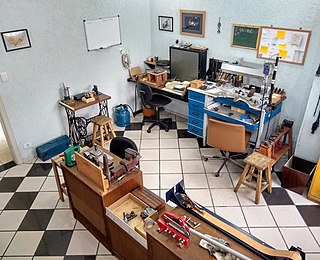
In metalworking and jewelry making, casting is a process in which a liquid metal is delivered into a mold that contains a negative impression of the intended shape. The metal is poured into the mold through a hollow channel called a sprue. The metal and mold are then cooled, and the metal part is extracted. Casting is most often used for making complex shapes that would be difficult or uneconomical to make by other methods.

A goldsmith is a metalworker who specializes in working with gold and other precious metals. Nowadays they mainly specialize in jewelry-making but historically, goldsmiths have also made silverware, platters, goblets, decorative and serviceable utensils, and ceremonial or religious items.

In hip hop culture, a grill, also known as fronts or golds, is a type of dental jewelry worn over the teeth. Grills are made of metal and are generally removable. They began to be worn by hip-hop artists in New York City in the early 1980s, and upgraded during the 1990s in Oakland. They became even more widely popular during the mid-2000s due to the rise of Southern hip hop rap and the more mainstream pop culture status hip hop attained.

Investment casting is an industrial process based on lost-wax casting, one of the oldest known metal-forming techniques. The term "lost-wax casting" can also refer to modern investment casting processes.

Downtown Miami is the urban city center of Miami, Florida, United States. The city's greater downtown region consists of the Central Business District, Brickell, the Historic District, Government Center, the Arts & Entertainment District, and Park West. It is divided by the Miami River and is bordered by Midtown Miami's Edgewater, and Wynwood sections to its north, Biscayne Bay to its east, the Health District and Overtown to its west, and Coconut Grove to its south.

The Alfred I. DuPont Building is a historic building in Miami, Florida. It is located at 169 East Flagler Street. Started in 1937 and completed in 1939, it is a 17-story rectangular building in the Modern style with Art Deco embellishments. It was the first skyscraper built after the County courthouse and the bust of 1928. Thus it represents Miami's emergence from the great depression. It replaced the Halcyon Hotel on this site. On January 4, 1989, it was added to the U.S. National Register of Historic Places.

In casting, a pattern is a replica of the object to be cast, used to form the sand mould cavity into which molten metal is poured during the casting process. Once the pattern has been used to form the sand mould cavity, the pattern is then removed, Molten metal is then poured into the sand mould cavity to produce the casting. The pattern is non consumable and can be reused to produce further sand moulds almost indefinitely.

A bench jeweler is an artisan who uses a combination of skills to make and repair jewelry. Some of the more common skills that a bench jeweler might employ include antique restoration, silversmithing, goldsmithing, stone setting, engraving, fabrication, wax carving, lost-wax casting, electroplating, forging, & polishing.
Zoltán Dávid (1955) is a Hungarian-born American jewelry designer based in Texas. His business, Zoltan David Precious Metal Art, opened in 1980 and has focused on individually crafted one-off pieces. On August 27, 1988, he was knighted by the Hungarian nation in honour of his father, Zoltan David I.

Casting is a manufacturing process in which a liquid material is usually poured into a mold, which contains a hollow cavity of the desired shape, and then allowed to solidify. The solidified part is also known as a casting, which is ejected or broken out of the mold to complete the process. Casting materials are usually metals or various time setting materials that cure after mixing two or more components together; examples are epoxy, concrete, plaster and clay. Casting is most often used for making complex shapes that would be otherwise difficult or uneconomical to make by other methods. Heavy equipment like machine tool beds, ships' propellers, etc. can be cast easily in the required size, rather than fabricating by joining several small pieces. Casting is a 7,000-year-old process. The oldest surviving casting is a copper frog from 3200 BC.

The House of Bolin is one of the oldest firms specialising in jewellery and silverware that remains in the hands of its founding family. The firm exists today as Jewellers and Silversmiths to HM the King of Sweden.
Ricardo Basta is an Argentine American jewelry designer based in Southern California and is known for sourcing only ethically mined gems and diamonds.
Henry Dunay is an American goldsmith and jewelry designer, best known for his fine scratched surface technique known as Sabi.
Tacori is an American jewelry design house and manufacturer based in Glendale, California. The brand is heavily associated with bridal jewelry.
Ben Bridge Jeweler is a high-end American jewelry retailer that sells engagement rings, diamonds and watches, including Rolex, among other luxury product and is currently owned by Warren Buffett's Berkshire Hathaway. It was established in Seattle, Washington, in 1912 and currently operates over 80 stores in the United States.

Black, Starr & Frost is an American jewellery company. Founded in 1810, the company is the oldest continuously operating jewellery firm in the United States. The company has acted as a retailer, rather than manufacturer, for most of its history.
Oscar Heyman & Brothers is an American fine jewellery design and manufacturing firm. The company is known for its expertise in manufacturing and for its use of colored gemstones. The company is known in the jewelry industry as ′The Jewelers’ Jeweler,′ which is the name of the book on the company researched, written, and published by the Museum of Fine Arts, Boston.
Eagle & Pearl Jewelers is an American jewelry retailer headquartered in Colorado. In 2020, it celebrated its 290th anniversary and is one of the world's oldest jewelry stores still in operation. It sells gemstone, pearl and unique designer gold and sterling silver jewelry. Eagle & Pearl is known for partnering with internationally acclaimed award-winning jewelry designers from around the world.
Kalevala is a Finnish jewelry brand owned by Kalevala Koru Oy, a company that designs, manufactures, and markets gold, silver, and bronze jewelry. Kalevala Koru Oy is the largest company in the jewelry industry in Finland and one of the largest in the Nordic countries. Their products are manufactured in Finland.











